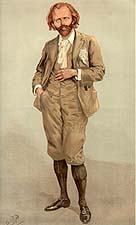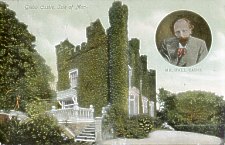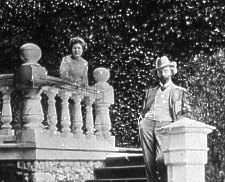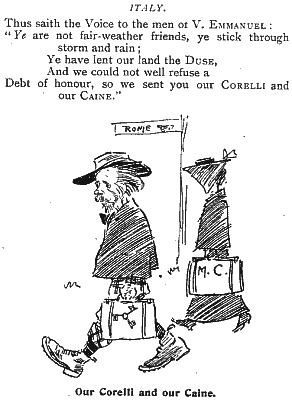Thomas Henry Hall Caine, 1853-1931
 Born
at Runcorn, Cheshire, 14 May 1853, to a Manx father and a Cumberland
mother and brought up in Liverpool; however spent considerable time
in his youth with uncle's family in Ballaugh and Manx grandmother.
Also spent some time helping a schoolmaster uncle at Kirk
Maughold.
Born
at Runcorn, Cheshire, 14 May 1853, to a Manx father and a Cumberland
mother and brought up in Liverpool; however spent considerable time
in his youth with uncle's family in Ballaugh and Manx grandmother.
Also spent some time helping a schoolmaster uncle at Kirk
Maughold.
Consumate self publicist and not always entirely truthful - not for nothing did Vivien Allen choose the punning subtitle
"Portrait of a Victorian Romancer" for her biography. Hall Caine's own biography "My
Story" contains few hard facts and where his early connection with the Island is concerned is somewhat misleading.
At times he postured as more Manx than the Manx who, though they
elected him MHK for many years, were deeply suspicious of him and
never warmed to him. Caine would appear to have recognised this for
in his note to "Recollections of Rossetti" he writes of
this Manx Schoolmastering period 'I had few books of poetry and I had
none of fiction, for what we afterwards called the Nonconformist
conscience had already penetrated our bleak solitude and our seniors
had no place for the authors who (as an unforgiving Manxman in later
years said of myself) "earned their living by telling lies".' Samuel
Norris, another comeover, who had personal memories of Hall Caine
barely conceals his dislike in his joint biography of Caine and the
undoubtedly greater T.E.Brown (another writer
who, though definitely Manx born, was treated with suspicion as
'laughing at the Manx'.)
For a thirty year period from c.1890 his novels, generally running to well over 300 pages sold in their 100,000s - his
plays were also successful in the Edwardian theatre and he was by far and away the most highly paid novelist of his day.
His friendship of Rossetti in his final drug-problemed years also gives Caine a claim to fame. For details of his friendship
with 'Jack the Ripper' see Vivien Allen's excellent biography.
Marriage
Hall Caine's early 'married' life was unconventional, whilst
staying in London in 1882 with a bachelor friend, the two had their
evening meals brought in from a nearby coffee shop. The two young
girls who worked there formed an attachment to the young journalists
- this was exploited by the girls' fathers to pressurise the pair
into making 'honest women' of the pair. Although it is likely that
only mild flirting had taken place, his friend Robinson agreed to
marry his girl but Caine was left with the 13 year old Mary Chandler,
who however adored him. Whilst he could legally marry her, Caine felt
she was too young (and very likely he was not in the mood to marry)
but did offer to pay for her education (yet another theme that landed
up in his novels). However in December 1882 Mary's stepfather threw
her out and Hall Caine took her into his small lodgings. Like Hall
Caine, who was small at 5'3", Mary too was small, pretty and with a
charming voice; many of his friends assumed that he too had bowed to
pressure and married her. Soon afterwards he sent her to Sevenoaks to
acquire some schooling and spent his free weekends with her. To keep
her company he allowed his young sister
Lily, then aged 13, to stay with her - she was sworn to secrecy
so that news of this strange arrangement did not leak back to his
Baptist chapel-going parents in Liverpool. Lily and Mary became
lifelong friends and Lily, who adored her elder brother, kept her
promise and no news leaked out until Hall Caine told them himself. As
might be expected Mary became pregnant in 1884 at the age of 14 - by
April, Mary and a housekeeper were installed at a house in Hampstead
(Hall Caine found new lodgings near the Law Courts) and Ralph Hall
Caine was born 15 August 1884. Delaying registering the birth for a
month Hall Caine perjured himself by describing the mother as "Mary
Alice Caine, formerly Chandler" - they were not actually to marry
until 3 September 1886, by declaration in Edinburgh, so that Hall
Caine could avoid any bad publicity. Even then he romanced somewhat,
giving her age as 23 whereas she was only 17 to his 33.
Greeba Castle
|

|
Hall Caine moved to the Island in 1894. Initially the
Caines rented Greeba Castle (not a castle but one of a pair
of castellated houses built 1849 and designed by John
Robinson of Douglas) standing above the Douglas-Peel
road. They later took a house in Peel before buying Greeba
Castle (by then in a poor state of repair) in 1896 which
remained his home until his death in 1931.
|
His house became, like those of today's Hollywood stars, a place for
tourists to gawp at - many postcards both of the house and/or Hall
Caine were issued. An interesting comment on the back of that
illustrated says "on way back passed the owner, funny looking
chap"!
|

|
His architectural training was used in his remodelling of
the house - the old door in the south face approached by
steep steps was replaced by a new one on the west face
approached by a terrace. This explains the drive shown above
which apparently terminates at some windows. He and his wife
were often photographed on this balustraded terrace, or as
he called it 'the piazza'.
|
Hall Caine was knighted in 1918.
Genealogy
Some connection to Hall Caine is claimed by many of Manx descent
(though I have seldom heard the same claim made on the Island!).
The family at Ballaugh described by Hall Caine in his
autobiography with whom he stayed, at the impressionable age of 5,
for the summer of 1858, following the birth of his sister were as
given in 1851 census:
Isabella Cain widow, (Hall Caine's paternal Grandmother) 64
William Cain , head of family, unmarried Butcher, (his uncle) 30 [sic - should be 39 or 40 - his age was correctly reported in 1841 census]
James Cain , unmarried Stone Mason, 27
Eliza, unmarried, 15.
Hall Caine's grandparents William and Isabel Clarke married at
Ballaugh 18 June 1811 and had the following 10 children (dates bapt or
birth)
|
William
|
7 May 1812
|
Butcher Uncle
|
|
Anne Jane
|
20 Feb 1814
|
|
|
Thomas
|
21 Jan 1816
|
N Crowe suggest died young as not mentioned in father's
will
|
|
Mary
|
16 Nov 1818
|
|
|
John
|
23 Jan 1821
|
Hall Caine's father
|
|
James
|
11 Jan 1824
|
|
|
Daniel
|
15 Jan 1826
|
|
|
Catherine
|
17 Mar 1829
|
married James Teare - the schoolmaster uncle
|
|
Christian
|
3 Aug 1832
|
|
|
Margaret Eliza
|
29 Jun 1836
|
|
John Caine (b 1821, d 1906) married Sarah
Hall (b 1829, d.1912) by whom he had six children
Thomas Henry Hall (b.14 May 1853, d. 31 Aug 1931)
John James (b. 21 Sep 1855, d. 2 Apr 1877)
Sarah Jane (b. 21 Jan 1858, d. 16 Mar 1863)
Emma (b. 7 Apr 1862 d. 27 Jun 1863)
William Ralph Hall (b 5 Feb 1865, d. 14 Jan 1939; m 1904 Mary
Elizabeth Levy (widow) no issue); William RH Caine became a
journalist, wrote "The Isle of Man" for A.C.Black and acted a a
publicist for Manx Tourism
Elizabeth Ann (Lily) b
13 Dec 1869 d. 31 May 1914; m. George David Day 5 Mar 1896 - one
son David Day) Lily often acted in Hall Caine's plays
Grandfather William died 1844, Isabella on 28 Jan 1866 after which
Hall Caine spent his summer holidays with his Aunt Catherine Teare.
His aunt Catherine had married James Teare at Braddan on 23 October
1858. James was schoolmaster at Maughold 1861-1870; they had 6
children before James died from tuberculosis in December 1871.
It was the death of his beloved maternal grandfather, Ralph Hall,
in January 1870, that affected him deeply - towards the end of 1870
he gave up his job as draughtsman in an Architect's office in
Liverpool and went to stay with his aunt. As James Teare was already
seriously ill, Hall Caine's arrival was welcomed as he could assist
in the school. He stayed on the Island for over a year - restoring a
deserted tholtan near the school as his Aunt's house would be
somewhat crowded. It is the insights and material which he acquired
at this time that he would recycle in his later Manx stories - much
to the annoyance of those who recognised themselves. He did however
fall in love with Maughold Head, even to the extent of buying, in
1909, a plot on the head for his grave, but when in 1931 shortly
before his death he found he could not manage the climb (and
disliking the thought that others would not then make the pilgrimage
to it that he hoped for) he bought a plot in Maughold yard where one
can see the huge memorial stone.
TBC
Punch in 1909 made fun of the common complaint that
Hall Caine's stories were all variations on the same theme. His passion for
visiting countries with an eye for self
advertisment is also mocked in the 1902 Punch cartoon

From Coronation issue and part of a supposed Gala Performance for their Majesties;
item eleven in the programme is "Mr. Rudyard Kipling, in his universal
athletic costume, will recite a New and Original Epochmaker, entitled, The Chantey
of the Nations."
References
Vivien Allen Hall Caine Portrait of a Victorian
Romancer Sheffield Academic Press (ISBN 1-85075-809-3)
1997
Hall Caine My Story London: William Heinemann 1908
(see also introduction to his
Master of Man)
C Fred Kenyon Hall Caine The Man
and the Novelist London:Greening & Co 1901
N. Crowe Notes on the Ancestry of Hall Caine IoMFHSoc vol 14 #4 pp122-124
1992
S. Norris Two Men of Manxland Douglas:Norris Modern
Press 1947
see also ILN 10 Oct 1891.
Publications
(only the major publications (or those with Manx interest) are given - fuller bibliographies in Cubbon
or by Vivien Allen.
The Restoration of Ancient Buildings. Papers by William Morris, Samuel Huggins,
J. J. Stevenson, etc., edited by T. H. Hall Caine. Royal Institution, Liverpool.
1877. Crown 8vo. 50 pp.
'Sonnets of Three Centuries; an anthology. [First edn.] London:
Elliot Stock. 1881. pp. 332. 50 copies on handmade paper were published in 1882
An old Manx Bard. Liverpool Weekly Mercury. 1882.
Recollections of D. G. Rossetti. [First edn.] 1882.
Cobwebs of Criticism: a Review of the First Reviewers of the 'Lake,' ' Satanic,'
and 'Cockney' Schools; by T. Hall Caine. [First edn. ] London: Elliot
Stock. 1883. p. xxiv,266.
The Shadow of a Crime. [First edn.] London: Chatto & Windus.
1885.
She's All the World to Me: a Manx Novel, by T. Hall Caine. New York:
Harper and Brothers. 1885. pp. 136. (Much was later recycled into the Deemster)
A Son of Hagar. [First edn.] London: Chatto & Windus. 1886.
pp. 303.
Life of Samuel Taylor Coleridge. [First edn.] London Walter
Scott. 1887. pp. 154,xxi.
The Deemster : a
romance. In 3 vols. [First edn.] London: Chatto & Windus. 1887.
pp. vi,304
Some old Manx Customs. In Liverpool Mercury. 1888. (Deals
with the Oie'l Voirrey, Hunting the Wren, etc.)
Ben-my-Chree : a drama (with Wilson Barrett). [First edn. ]
1888.
The Bondman : a New Saga. In 3 vols. [First edn.] London : Heinemann.
1890. pp. xi,254 (first appeared in installments in Isle of Man Times).
Little Manx
Nation, [First edn.] London: Heinemann. 1891. pp. 159
(Three lectures delivered at the Royal Institution on Jan. 22, 29,
and Feb. 5, 1891.)
The Scapegoat: a Romance. [First edn. ] London:
Heinemann. 1891. pp. x,318.
Mary Magdalene, the new Apocrypha. 1891.
The Fate of Fenella. 3 vols. illustrated. 1892.
The Jew in Literature. The Author. June, 1892.
Cap'n Davy's Honeymoon; The Last Confession; The Blind Mother. [First
edn.] London: Heinemann. 1893.
The Mahdi : or Love and Race. A Drama in Story. [First edn. ]
London: James Clarke & Co. 1894. (100 copies only Reprinted from the Christmas
Number of `The Christian World' for private circulation)
Little Man Island
; Scenes and specimen days in the Isle of Man.
I.M.S.P. Co. Douglas. 1894. pp. 50. Illus.
The Manxman. [First edn. ] London: Heinemann. 1894. pp.
vi,439.
Graih my Chree, a poem. Lyra Celtica, ed. by E. A. Sharp
and J. Matthay. pp. 309-314. [4192, j 8]
Graih my Chree (a Manx Ballad). In London Home Monthly, March
1895. London : Horace Cox. 1895. pp. 33-48
Jan the Icelander. In Home Sweet Home. (100 copies only.) 1896.
The Christian. A story. London: Heinemann. 1897. pp. iv,453
Illus (The Christian. First appeared in Windsor Mag. as a serial
commencing in Dec. 1896).
T. E. Brown : in Memoriam. In LRI.T. 1897.
The Christian: a drama. London: Horace Cox. 1898. pp. 106.
The Eternal City. London: Heinemann. 1901. pp. vi,606.. (first appeared
in The Lady's Mag. ]
Letters and Speeches on Manx Politics. Douglas : S.K,B 1903. pp. 72. (The speeches,
letters, and articles which make up the pamphlet were gathered together for
publication immediately after the date of Mr. Hall Caine's election to the House
of Keys as representative for Ramsey, Thomas Cowley, April 10, 1903.)
The Prodigal Son. [First edn.] London : Heinemann. 1904. pp.
viii,426.
The Prodigal Son. A drama in four acts, by Hall Caine. [First edn.]
Heinemann. 1905. pp. viii,252. (This play was performed for copyright purposes
at the Grand Theatre, Douglas, on
Nov. 2, 1904)
The Prodigal Son: a novelised version of Mr. Hall Caine's Play; by S.
R. Squires. Derby: Bacon & Hudson. c. 1905.
Drink : a love story on a great question. Illus. by Cyrus Cuneo.
London: George Newnes. 1906. pp. v,118.
The Bondman Play. The Daily Mail. 1906. pp. xvi,240. Illus.
Pete : a Drama in four acts. By Hall Caine and Louis N. Parker. Dramatised
from 'Mr. Hall Caine's novel 'The Manxman.' London: Collier & Co. 1908.
pp. iv,164.
My Story. London:
Heinemann. 1908. pp. xiii,406. +Portrait (first appeared In English Writers of To-day series. No. 4. In M.A.P. April 18th
to Sept. 19th, 1908.
The Bishop's Son. A new Drama in four acts. Printed for private circulation.
London. 1910. pp. viii,88
The Drama of Three Hundred and Sixty-five Days
: scenes of the Great War. Heinemann. 1915. pp. 127. (Reprinted, with additions, from The Daily Telegraph.)
Our Girls Hutchinson 1916 pp127 + 15 ilustrations
The Master of Man; the story of a sin. [First edn.] London :
Heinemanm. 1921. pp. viii,432.
The Woman Thou Gavest Me. 1921.
The Woman of Knockaloe. A parable.
London : Cassell Co. 1923. pp. xvi,208. (later re-issued as Barbed Wire)
Graih my Chree. In Lyra Celtica, 2nd edn. 1924, p. 309, with biog.
note p. 442.
 Born
at Runcorn, Cheshire, 14 May 1853, to a Manx father and a Cumberland
mother and brought up in Liverpool; however spent considerable time
in his youth with uncle's family in Ballaugh and Manx grandmother.
Also spent some time helping a schoolmaster uncle at Kirk
Maughold.
Born
at Runcorn, Cheshire, 14 May 1853, to a Manx father and a Cumberland
mother and brought up in Liverpool; however spent considerable time
in his youth with uncle's family in Ballaugh and Manx grandmother.
Also spent some time helping a schoolmaster uncle at Kirk
Maughold.

